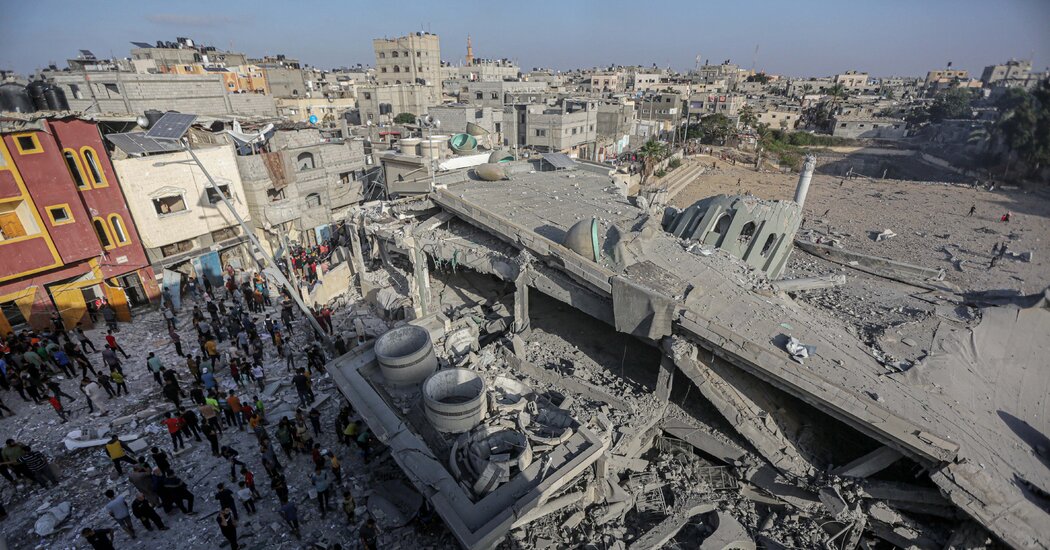[ad_1]
What lies ahead in Gaza?
Antony Blinken, the U.S. secretary of state, said yesterday that Gaza should be unified with the West Bank under the Palestinian Authority once the war ends, the strongest signal yet of the Biden administration’s hopes for the future of the conflict. But what Israel will do in Gaza is largely unclear.
Patrick Kingsley, The Times’s Jerusalem bureau chief, who covers Israel and the occupied territories, explains what may lie ahead.
What are you expecting?
If Israel continues as planned, the next few weeks could be the bloodiest of the war so far. Already, roughly 1,400 Israelis and over 10,000 Palestinians in Gaza have been killed, according to the Hamas-run health authorities in Gaza.
That death toll could rise once Israel starts fighting in earnest within the urban warren that is Gaza City, which is Hamas’s stronghold and the primary target of Israel’s invasion. Once Israeli forces enter en masse, we will see very intense urban warfare, in part because this is Hamas’s home turf. It’s where they’ve built and dug hundreds of miles of subterranean tunnels from which they can emerge and launch ambushes that will stymie the Israeli army’s progress.
The biggest question is what Israel’s army will do once they reach the hospitals in central Gaza City, which they claim are the headquarters of Hamas’s military command. While they haven’t clearly said this, the implication is that they are going to have to take over these hospitals in order to complete their goal of removing Hamas from the Gaza Strip.
Doing so would see fierce fighting inside a location that is supposed to be off limits during a war. And we could be about to witness some very troubling scenes of violence inside places that are supposed to be sanctuaries.
What’s Israel’s endgame in Gaza?
Israel’s plan is still quite vague. They’ve said they want to disband Hamas’s political leadership and military capabilities. They’ve also said that they will retain security control of Gaza “indefinitely.” But it isn’t clear how long they plan to take to do that, or how much time the U.S. government will give them to do that before they start to withdraw their support.
It’s also not clear how much time Israel has to do that before there starts to be regional repercussions — like the entry of Hezbollah, the Lebanese militia, into the war — that will force them to rethink their strategy in Gaza.
What’s the mood in Israel?
It’s one of turmoil, profound pain and grief. Oct. 7 was the deadliest day for Jews since the Holocaust ended, according to Israeli officials, and the idea of families burned alive by Hamas or their allies, civilians shot dead in the streets, in their homes, has been extremely triggering.
There’s also a deep sense of anger at the government and the security services for having allowed the attack on Oct. 7 to occur. And there’s a lack of faith, according to recent polls, in Prime Minister Benjamin Netanyahu’s ability to lead Israel out of this crisis.
How do the Palestinians feel?
The mood among Palestinians is one of real terror and fear. They fear a mass displacement from the Gaza Strip and the West Bank. They are already grieving and mourning the largest number of civilians to die in the Israeli-Palestinian conflict since 1982, when Israel invaded Lebanon. And they fear that much more bloodshed is to come.
As Israel’s bombing continues and Israel’s ground invasion gets closer to the heart of Gaza City, they also feel abandoned by the West and the U.S., which they perceive to have wholly taken Israel’s side.
In other news from the war:
Ukraine accuses Russia of strike on civilian ship
An anti-radar Russian missile struck a civilian ship while it was moored in a port in the Black Sea region of Odesa, the Ukrainian authorities said, killing a port pilot on board and injuring three crew members and a port worker. The claim could not be immediately verified. The Russian authorities did not immediately comment on the strike.
If confirmed, the attack would be the first time that Russian forces had hit a civilian vessel sailing near the Odesa region since Moscow pulled out of a U.N.-brokered deal in July that allowed Ukraine to export its grain through the Black Sea.
In other news: The E.U.’s executive arm recommended that the bloc open membership talks with Ukraine, an encouraging step for Kyiv in what remains a long process.
THE LATEST NEWS
Around the World
Danny Taing’s 55,000 rare Kit Kats, valued at $250,000, began their long, twisted and sometimes obscure journey in Japan. Their destination was Carlstadt, N.J. — and eventually the hands of avid candy fans.
The Kit Kats made it to the U.S. But days after any cross-country trip should have been completed, they were nowhere to be found. Were they melting in the summer heat? Was a Kit Kat junkie gorging on chocolaty plunder? What had happened to the candy bars?
Lives Lived
Oleg Protopopov, a champion Russian skater who, with his wife, Ludmila Belousova, revolutionized pairs figure skating before defecting to the West, has died at 91.
SPORTS NEWS
‘Dollar-rumma’ anger: A hostile return to Milan for Gianluigi Donnarumma.
Remembering José Antonio Reyes: Sevilla’s son and Arsenal’s Invincible.
Formula 1’s coldest race ever? Las Vegas will challenge drivers, teams and tires.
The next Costume Institute blockbuster
Despite the name — “Sleeping Beauties: Reawakening Fashion” — there’s no Disney connection to the theme for the Metropolitan Museum of Art’s next fashion bonanza.
Instead, the show was inspired by the ephemeral nature of nature, and how fashion captures that literally, in the form of garments inspired by and decorated with flora and fauna, and conceptually, in its endless cycle of in and out, its potential to degrade.
“Think of it as a show devoted to unsustainable fashion,” Vanessa Friedman, our chief fashion critic, writes, “one that could function as a requiem, a warning sign and a reminder of the fundamental importance of regeneration.”
Related: In an era of expediency, styles inspired by gastropods like snails are oozing onto the runway.
RECOMMENDATIONS
That’s it for today’s briefing. See you tomorrow. — Natasha
P.S. The critic Alissa Wilkinson is joining The Times from Vox to cover movies.
You can reach Natasha and the team at briefing@nytimes.com.
[ad_2]
Source link




